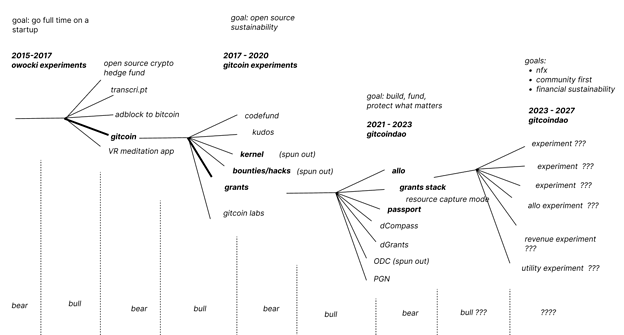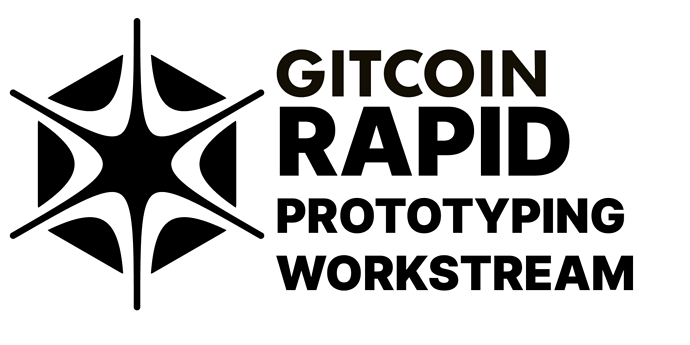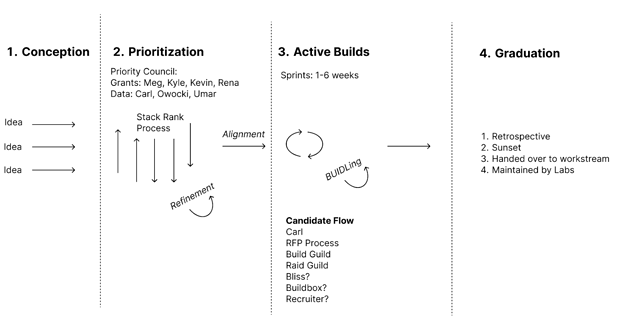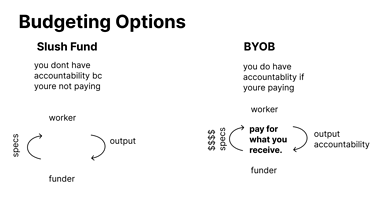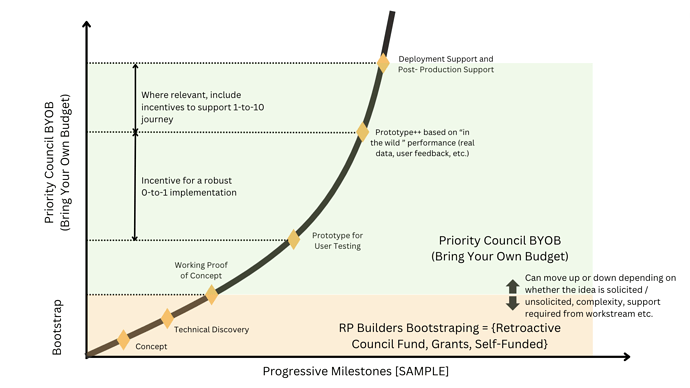Abstract
In this post, I would like to talk about the history of new market exploration & product innovation at Gitcoin. I will then float some ideas around Rapid Prototyping. A Rapid Prototyping pod/workstream. could be in charge of creating value for Gitcoin by way of 0 to 1 product innovation.
History of Product Exploration at Gitcoin 2015-2023
Gitcoin has had a rich history of exploration in the web3 design space through the years. As the market cycled through bull + bear + back again several times, Gitcoin has explored the design space organically.
Here is what the history of product exploration at Gitcoin looks like in my minds eye (and in the case of 2015-2017 cycle, what led to the creation of Gitcoin):
Some patterns I see:
- In bull markets, I’ve typically shepherded many bets forward. By casting multiple bets, we are able to see what sticks without going all in on one idea…
- In a bear market, there is hard work to do regarding which projects to focus and double down on.
- This has meant that projects that are ngmi get shut down (codefund, Gitcoin Labs 1.0, original dGrants, etc).
- This means that projects that are gonna make it, but are not within Gitcoin’s core focus (hackathons, KERNEL), get spun out…
- What is left is what we focus on + double down on in the next cycle.
- Repeat until mission achieved!
Now that Gitcoin has matured into an organization of dozens of contributors + thousands of users…. We have an opportunity to double down on maturing the projects that have been created by this cycle of innovation.
In many ways, maturing/scaling products is very different from proving product market fit for them. For example, I am very good at bringing products to market rapidly (skills needed: code quickly, validate market needs, get the first few customers), but I am very bad at scaling them (skills needed: code documentation, writing clean code, staffing them, designing an org that can serve them).
I believe that the existing product workstreams can continue to bring the latter skills (scaling Grants products at Gitcoin), but that there might be an opportunity to complement the scaled products with prototypes that complement them (especially when they are both built on the same Allo Protocol v2). One good example of this is https://reportcards.gitcoin.co/ - which is a total prototype, but compliments the more mature Grants Stack very wall.
Past Successes
- Gitcoin Labs 1.0 (2019)
- Burner Wallet
- Other early research
- Gitcoin 2020 spinouts
- Hackathons
- KERNEL
- Moonshot Collective Era (2021-22):
- Moonshot Bots: Raised $3m
- ProofofStake.gitcoin.co - Raised $1m
- ID Staking - 1m GTC Staked, foundation of ID staking v2
- Supermodular Era (2023):
- Report Cards - Made it easy for Round Managers to show progress.
- EasyRetroPGF - Got us into RPGF, new market trend.
- Grants-ETL - Foundation for data scientists + created conditions for Cluster Mapping to take off.
- Hypercerts - we assisted in the conception/launch.
Past Learning Experiences
- Gitcoin 2020 era
- Codefund
- Gitcoin Quests
- Gitcoin Kudos
- Themes: Many of these died on the vine because we could not support them in a small team that was already spread across Hackathons/Grants/KERNEL. If we had been able to build teams around each product category, I am curious to see if in that counterfactual version of the world if Kudos could have become a POAP competitor, or Gitcoin Quests could have become a Rabbithole competitor.
- Moonshot Collective Era (2021-22)
- Coordination Party Kit
- Partnership Protocol
- Themes: Lots of builders with energy, but we hired the wrong project manager. Gitcoin was also fairly aimless at this point (had no essential intents) so MSC was similarly fractured in attention. Once Owocki left it was a long slow wind down into becoming GPC. But a few ppl still here!
- Supermodular Era (2023)
- PGN Bridges
- Quadratic Honey
- Quadratic Yeeter
- Funding.Social
- Many more…
- Themes: Hard to build on top of Allo/Grants Stack when its wet cement. We had a higher hit rate than before tho. Lots of learnings that led to Gitcoin Labs.
Rapid Prototyping Workstream (RPW) in 2024
Now that we have studied the history of innovation in the Gitcoin ecosystem, I would like to show off my latest thinking about Rapid Prototyping for the current era.
Purpose:
Why do this?
- Create Value for Gitcoin by Rapid Prototyping in Highest Value Areas.
- Create Alignment among stakeholders.
How does it serve Gitcoin?
- Acts as a 0-1 booster/assist for 0-10 product workstreams
- (0 to 10 involves going through 0 to 1).
- Gives Gitcoin More Agility in Rapidly Changing Market
- If we are successful, we preempt the next hot trend that has historically left Gitcoin behind (some good examples of things that have traction and that have left Gitcoin behind: MACI, RPGF, Hypercerts).
Success KPIs
- Higher Hit Rate than past Rapid Prototyping workstreams. Hit rate 5/10 instead of 2/10.
- Hits are bigger hits > base hits
The Process
- Idea Conception - this is already happening normally.
- Prioritization.
- The Priority Council meets on a regular interval to stack rank the ideas.
- An output of this step is alignment. The priority council, instead of working in 5 different directions, we can now align on less directions.
- Emergently, executive sponsors will emerge to fund active builds.
- Active Builds
- Kevin will maintain a roster of builders who are web3 native.
- He will make intros to them.
- Others are welcome to do the same.
- Whomever is the executive sponsor of an idea coming out of prioritization brings their own budget for the build.
- Graduation
- Projects will do a retrospective and decide to
- Sunset ⇐= default
- Hand over to workstream
- Be given a maintenance budget
Budget
Initial thoughts: $0/mo in overhead. Each Priority Council BYOB (Bring Your Own Budget) to fund on a project by project basis.
I wanted to specifically avoid having a slush fund ppl can draw from. BYOB aligns incentives between the ppl who pay + those who get value.
Initial Priority Councils.
- Grants: Meg, Owocki, Kyle, Rena
- Passport: Jeremy, Kyle, Rena, Owocki
- RegenLearnings.xyz: Kevin, Carl Cervone, Jonas
- Allo: Nate, Zakk, Kevin
If we are successful in this,
- throughput should roughly equal costs
- confidence can grow/scale linearly to budget.
Risks
- Cultural aversion to 0 to 1 style working in 1 to 10 style workstreams.
- Lack of sense of urgency to compete more aggressively or be more agilie in market.
- How do we open up Allo/Grants Stack to more community contributions?
- Talent might be tight in a bull market.
- Cultural differences between 0 to 1 teams and 1 to 10 teams. In case of a handoff from 1 workstream to another, the ability to knowledge transfer between RP builders + next builders may be a risk.
Open Questions
- Should RP be a standalone protocol/process or is this a new team we’re forming?
- If it is a new team, what should its budget be, and how do we solve for accountability?
- If you are a workstream lead, do you need RPW enough that you’d request a line item in you budget for it? @meglister @Viriya @kyle @deltajuliet @jeremy
Please give me feedback on this Temp Check post!
